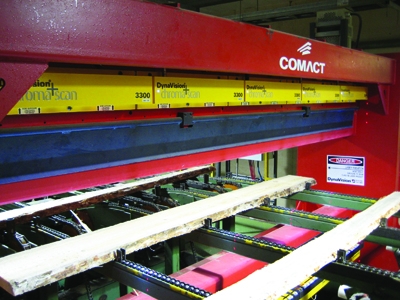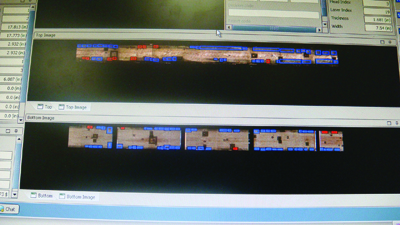
New Gear
Equipment
Sawmilling
Double Vision
Like many sawmills in the BC Interior, L&M Lumber and Lakeland Mills have been struggling with the effects of dry, brittle beetle kill lumber. The two independent, modern sawmills are no strangers to scanning and optimization technology, but as beetle kill wood ages, it tests the limits of most traditional optimization packages. Solutions deemed acceptable by even the most impressive full-profile geometric scanners are chosen, only to have the cracked board explode further down the line. Lost production time, slower feed speeds, and reduced recovery are the results.
November 30, 2011 By Scott Jamieson
 The DynaVision chroma+scan 3300 sensor from LMI Technologies can detect board defects earlier in the production process. The sensor is shown here installed on a Comact EdgeExpert system in the BC Interior. Photo: Courtesy Comact. Like many sawmills in the BC Interior
The DynaVision chroma+scan 3300 sensor from LMI Technologies can detect board defects earlier in the production process. The sensor is shown here installed on a Comact EdgeExpert system in the BC Interior. Photo: Courtesy Comact. Like many sawmills in the BC Interior
“These mills were having to slow down production speed at the sawmill edger to deal with the cracks from the beetle wood,” explains Yvon Hubert, VP optimization and controls at Comact. So late in 2007, the sawmill supplier installed a retrofit to the mill’s Comact transverse edger optimizers to deal with the issue. The solution came in the form of new scanners from LMI Technologies. The DynaVision chroma+scan 3300 sensor integrates high-density 3D differential profiles and true colour vision for defect detection that includes the cracks giving BC Interior sawmillers their own version of the shakes.

Combining these two technologies into a single sensor system provides the sawmill with the means to increase the value of each cutting decision at the sawmill edger and trimmer, reducing production logjams there and further downstream, reducing wasted processes on unsound lumber (i.e. drying or planing unsound pieces), and allowing some mills to target certain boards for added value or customized processing. This field-proven technology provides early detection of wood defects, such as cracks, stains, knots, and pitch pockets from the boards, allowing mills to move defect detection from the planer mill to the sawmill, moving from damage control to proactive, optimized sawing in the process.
Early detection
At L&M Lumber and Lakeland, the retrofit install of the chroma+scan 3300 sensor allows the optimizer to consider not just geometric information in creating a cutting solution, but also defects like cracks. “The cracks from the beetle kill wood can be factored into the optimized solution,” Hubert says, “or the mills have the option of just rejecting the board right there rather than allowing it to split up and cause downtime.” There are more applications for this technology, and Comact has been using the chroma+scan 3300 to help solve other customers’ challenges. In the case of one southern yellow pine (SYP) mill in Georgia, Tolleson Lumber, a retrofit at the sawmill trimmer is helping the mill look for opportunity wood rather than trouble pieces. The mill is using the scanner/optimizer package to target clears, which are sorted out and processed into value-added, custom products. It’s an approach that would also fit today’s hardwood mills, as they try to maximize NHLA grade values while making special products with the downfall.
Another mill in New Brunswick has ordered a sawmill trimmer retrofit with chroma+scan sensors to identify rot in its balsam fir lumber. This way the problem pieces can be rejected or the rot removed at the sawmill, instead of wasting precious drying and planer time. There are also hardwood applications for this technology, although Hubert cautions that they are just getting started with the chroma+scan 3300 in this segment. The supplier has installed the system at a Quebec hardwood mill, and is currently working to reach NHLA standards. Hubert adds that the new technology opens up many options for sawmillers struggling to improve margin.
“Mills can now make better decisions at the edger. Colour vision provides a solution for specific problems that have occurred, such as split wood. They can also do a better job sorting out specific target products at the trimmer, or remove problematic rot right there, without wasting anymore production time or investing more money in the board.”
When it comes to rot in fir or cracks in beetle kill pine, even what you can see can hurt you. It just hurts a whole lot less if you see it, and deal with it, early.
Print this page